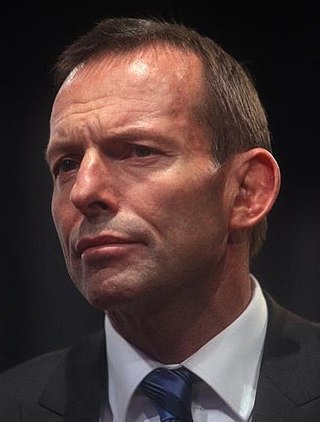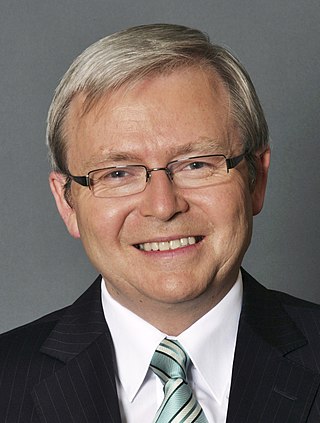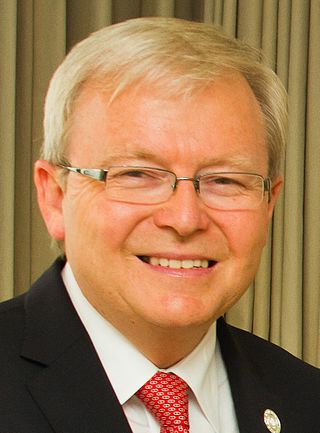Proposal for direct local council funding
| This article is part of a series on the |
| Politics of Australia |
|---|
 |
| Constitution |
An Australian constitutional referendum was planned, and then abandoned, in 2013.
| This article is part of a series on the |
| Politics of Australia |
|---|
 |
| Constitution |
An Australian constitutional referendum was planned, and then abandoned, in 2013.
The referendum was proposed to change section 96 of the Constitution of Australia to allow the Commonwealth of Australia to directly fund local councils. [1] Similar referendums failed to pass in 1974 and 1988.[ citation needed ]
The proposed constitutional alteration was passed by both Houses of Parliament as the Constitution Alteration (Local Government) 2013. [2]
The "yes" campaign was supported by both the Labor government and the opposition leader Tony Abbott. [1]
The federal government allocated $10 million to the "yes" campaign, but just $500,000 to the "no" campaign. The difference in funding led seven senators from the Coalition to vote against the referendum bill in the Senate, although it passed by 46 votes to eight. [1]
Section 128 of the Constitution requires a proposed constitutional amendment be submitted to the electors in a referendum no less than two months but no later than six months after passage. The referendum was originally planned to be held on the same day as the 2013 federal election, originally set for 14 September 2013. However, on 4 August, Prime Minister Kevin Rudd changed the general election date to 7 September, [3] and Local Government Minister Catherine King announced that the referendum would be held on a later date. [3]
The Australian Labor Party was defeated at the 7 September 2013 federal election, and in October 2013 the Abbott Coalition government announced it would not proceed with the referendum. [4]
Republicanism in Australia is a popular movement to change Australia's system of government from a constitutional parliamentary monarchy to a republic, replacing the monarch of Australia with a president. Republicanism was first espoused in Australia before Federation in 1901. After a period of decline after Federation, the movement again became prominent at the end of the 20th century after successive legal and socio-cultural changes loosened Australia's ties with the United Kingdom.

Malcolm Bligh Turnbull is an Australian former politician and businessman who served as the 29th prime minister of Australia from 2015 to 2018. He held office as leader of the Liberal Party of Australia.

Julia Eileen Gillard is an Australian former politician who served as the 27th prime minister of Australia from 2010 to 2013, holding office as leader of the Australian Labor Party (ALP). She previously served as the 13th deputy prime minister of Australia from 2007 to 2010, under Prime Minister Kevin Rudd. She is the first and only female to hold either office in Australian history.

Anthony John Abbott is a British-born Australian former politician who served as the 28th prime minister of Australia from 2013 to 2015. He held office as the leader of the Liberal Party of Australia.

The 2007 Australian federal election was held in Australia on 24 November 2007. All 150 seats in the House of Representatives and 40 of the seats in the 76-member Senate were up for election. The election featured a 39-day campaign, with 13.6 million Australians enrolled to vote.

The Australian Government, also known as the Commonwealth Government, is the national government of Australia, a federal parliamentary constitutional monarchy. Like other Westminster-style systems of government, the Australian Government is made up of three branches: the executive, the legislative, and the judicial.
In Australia, referendums are public votes held on important issues where the electorate may approve or reject a certain proposal. The term is commonly used in reference to a constitutional referendum which is legally required to make a change to the Constitution of Australia.

The Australian republic referendum held on 6 November 1999 was a two-question referendum to amend the Constitution of Australia. The first question asked whether Australia should become a republic with a President appointed by Parliament following a bi-partisan appointment model which had been approved by a half-elected, half-appointed Constitutional Convention held in Canberra in February 1998. The second question, generally deemed to be far less important politically, asked whether Australia should alter the Constitution to insert a preamble. For some years opinion polls had suggested that a majority of the electorate favoured a republic. Nonetheless, the republic referendum was defeated, in large part due to division among republicans on the method proposed for selection of the president.

On 22 September 1951, a referendum was held in Australia which sought approval to alter the Australian Constitution to give Parliament the power to make laws regarding communism and communists, so that the Parliament would be empowered to instate a law similar to the Communist Party Dissolution Act of 1950. It was not carried.

A leadership spill occurred in the Australian Labor Party on 24 June 2010. Kevin Rudd, the prime minister of Australia, was challenged by Julia Gillard, the deputy prime minister of Australia, for the leadership of the Australian Labor Party. Gillard won the election unopposed after Rudd declined to contest, choosing instead to resign. Gillard was duly sworn in as prime minister by Quentin Bryce, the Governor-General, on 24 June 2010 at Government House, becoming Australia's first female prime minister.

The Gillard government was the Government of Australia led by the 27th Prime Minister of Australia, Julia Gillard, of the Australian Labor Party. The Gillard government succeeded the first Rudd government by way of the Labor Party leadership spill, and began on 24 June 2010, with Gillard sworn in as Prime Minister by the Governor-General of Australia, Quentin Bryce. The Gillard government ended when Kevin Rudd won back the leadership of the Australian Labor Party on 26 June 2013 and commenced the second Rudd government.

The 2013 Australian federal election to elect the members of the 44th Parliament of Australia took place on 7 September 2013. The centre-right Liberal/National Coalition opposition led by Opposition leader Tony Abbott of the Liberal Party of Australia and Coalition partner the National Party of Australia, led by Warren Truss, defeated the incumbent centre-left Labor Party government of Prime Minister Kevin Rudd in a landslide. It was also the third time in history that a party won 90 or more seats at an Australian election. Labor had been in government for six years since being elected in the 2007 election. This election marked the end of the Rudd-Gillard-Rudd Labor government and the start of the 9 year long Abbott-Turnbull-Morrison Liberal-National Coalition government. Abbott was sworn in by the Governor-General, Quentin Bryce, as Australia's new Prime Minister on 18 September 2013, along with the Abbott Ministry. The 44th Parliament of Australia opened on 12 November 2013, with the members of the House of Representatives and territory senators sworn in. The state senators were sworn in by the next Governor-General Peter Cosgrove on 7 July 2014, with their six-year terms commencing on 1 July.

The Clean Energy Act 2011 was an Act of the Australian Parliament, the main Act in a package of legislation that established an Australian emissions trading scheme (ETS), to be preceded by a three-year period of fixed carbon pricing in Australia designed to reduce carbon dioxide emissions as part of efforts to combat global warming.

The second Rudd government was the federal executive Government of Australia led by Prime Minister Kevin Rudd of the Australian Labor Party. It commenced on 27 June 2013 and ceased on 18 September 2013. Rudd had previously served a term as Prime Minister from 2007 to 2010 and been replaced by his deputy Julia Gillard, following an internal party spill. Rudd regained the Labor Party leadership by successfully re-challenging Gillard in a June 2013 party spill. On 5 August, Rudd called an election for 7 September 2013, which resulted in the defeat of his government by the Liberal/National Coalition led by Opposition Leader Tony Abbott.

The Abbott government was the federal executive government of Australia led by the 28th Prime Minister Tony Abbott. The government was made up of members of the Liberal–National Coalition. The Leader of The Nationals, Warren Truss, served as Deputy Prime Minister. Following the 2013 Australian federal election held on 7 September, the Coalition defeated the second Rudd government, ending six years of Labor government. The Abbott government was sworn into office on 18 September 2013. Less than two years later on 14 September 2015, Malcolm Turnbull defeated Abbott in a leadership ballot, 54 votes to 44 and the Turnbull government became the executive government of Australia.

The Turnbull government was the federal executive government of Australia led by the 29th prime minister of Australia, Malcolm Turnbull, from 2015 to 2018. It succeeded the Abbott government, which brought the Coalition to power at the 2013 Australian federal election. The government consisted of members of Australia's Liberal-Nationals Coalition. Turnbull took office by challenging his leader, Tony Abbott, in an internal leadership ballot. Warren Truss, the leader of the Nationals, served as Deputy Prime Minister until he retired in 2016 and was replaced by Barnaby Joyce. Joyce resigned in February 2018 and the Nationals' new leader Michael McCormack became Deputy Prime Minister. The Turnbull government concluded with Turnbull's resignation ahead of internal leadership ballot which saw him succeeded as Prime Minister by Scott Morrison and the Morrison government.
The history of same-sex marriage in Australia includes its express prohibition by the Howard government in 2004 and its eventual legalisation by the Parliament in December 2017. Although a same-sex marriage law was passed by the Australian Capital Territory in 2013, it was struck down by the High Court on the basis of inconsistency with federal law. The Court's decision closed the possibility of concurrent state or territory laws that would allow same-sex marriage where federal law did not. A law legalising same-sex marriage passed the Parliament on 7 December 2017 and received royal assent the following day.
The Aboriginal and Torres Strait Islander Voice, also known as the Indigenous Voice to Parliament or the Voice, is a proposed Australian federal advisory body comprising Aboriginal and Torres Strait Islander people to represent the views of Indigenous communities. If approved in an upcoming referendum called by the Albanese Government, the Voice would be empowered by the Australian Constitution to make representations to the Parliament of Australia and executive government on matters relating to Indigenous Australians. If the referendum vote is successful, the government will then design the specific form of the Voice, which will then be implemented via legislation passed by Parliament.
Constitutional recognition of Indigenous Australians has been campaigned for since 1910, including having an Indigenous voice to parliament enshrined in the Constitution of Australia.
The 2023 Australian Indigenous Voice referendum will ask voters to approve an alteration to the Australian constitution, creating the Aboriginal and Torres Strait Islander Voice to represent Indigenous Australians to the parliament and federal government on matters of Indigenous affairs. The referendum, prepared by the National Indigenous Australians Agency and conducted by the Australian Electoral Commission, will be held sometime between October and December 2023.